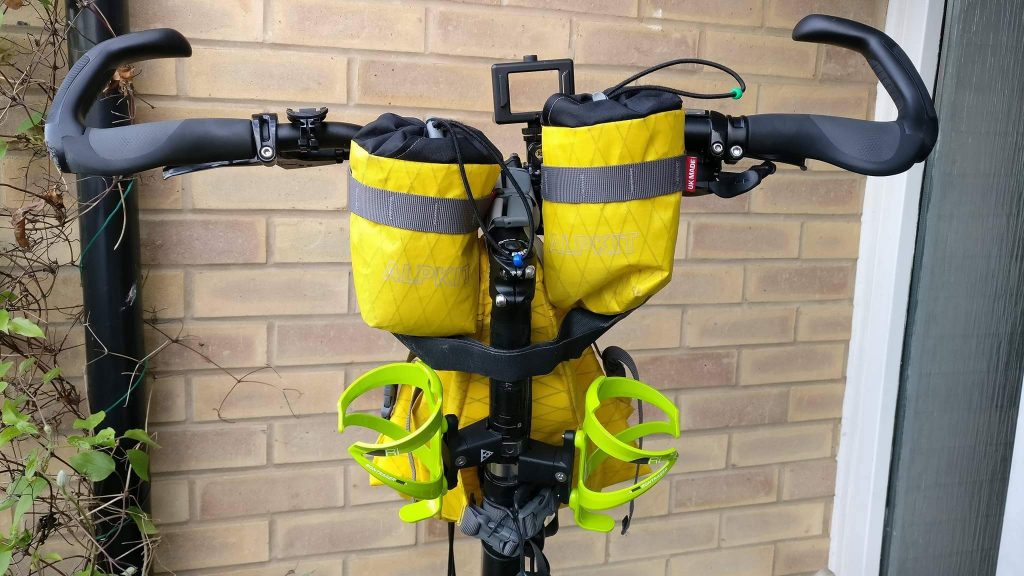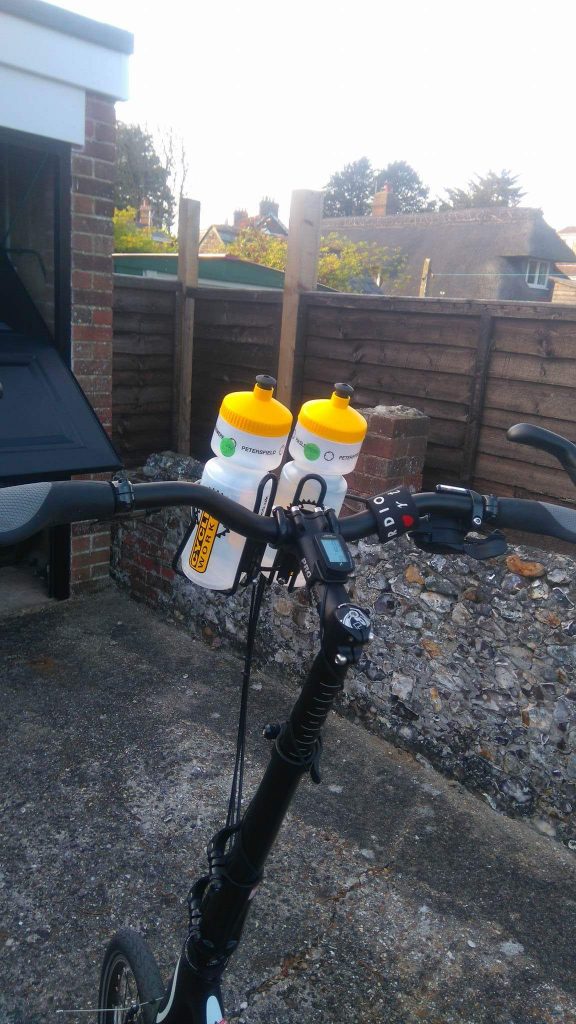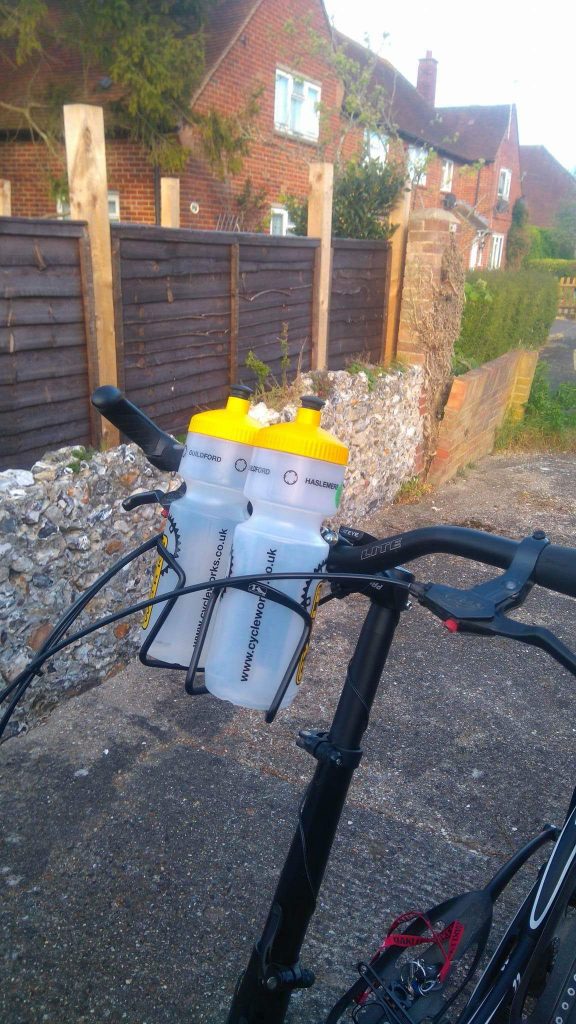By Idai Makaya (published on 8 April 2017):
I’ve been asked a few times about this topic, by riders who are still new to long-distance endurance cycling on the ElliptiGO – and I will start by saying “I’m no expert on packing for the bike”. But I do have lots of experience and lots of insight into what other riders do (or have done) and hopefully I can help in this capacity.
The tendency, as riders ‘evolve’, is to carry less and less stuff with them. I used to carry loads of stuff with me when I first got into multi-day riding. And I would always take advantage of all the bag-drop and vehicle carriage options offered at long-distance-cycling events. But nowadays I go out on long rides knowing that a shower is usually optional – rather than mandatory – and knowing that apart from clothing to anticipate the weather conditions, one doesn’t really need too much on a long bike ride.
My luggage for my 5-day ride from Land’s End to John o’Groats is shown in the image below:
![20160525_203303[1]](http://idaimakaya.com/wp-content/uploads/2016/06/20160525_2033031-1024x576.jpg)
That is all I took:
One jacket, one bivvy sleeping bag, two t-shirts, one base layer top, short leggings, long leggings, two handkerchiefs (no idea why, just in case, I suppose), three pairs of socks, three sets of underpants, two pairs of long-fingered cycling gloves, one pair of fingerless cycling gloves, a small vaseline container (for my face & lips), a bottle of sunscreen, toothpast and a toothbrush, an alarm clock (I needed a loud alarm because I was ‘rough camping’ – sleeping roadside – so I needed to be sure not to oversleep, with the tight time limits I was facing).
The rest of my bike carriage space was used to carry food. Remember, I tend eat once every hour, on the bike. I stop at shops to re-stock and to get more varied meals at four hour intervals, but between shops need to eat my own snacks on the bike, without stopping. You can see how I pack my bike in the photo below (my backpack and handlebar bags take mainly my on-the-bike food, and batteries). The rest of the bike spaces carry clothing and the heavier stuff (mainly the stuff which does not need to be taken out very often). The stuff I need regularly goes in the easy-access backpack and handlebar bag.
![20160529_193505[1]](http://idaimakaya.com/wp-content/uploads/2016/06/20160529_1935051-e1465407792527-576x1024.jpg)
My way isn’t necessarily the best way – and I have also compiled what I’d call an ‘exhaustive’ list of stuff to carry, which has been used by other multi-day riders and can all fit onto one bike and rider. The listing looks long – because it is – but these are mainly tiny items (which do not take up much space). It is possible – and has been demonstrated to be possible – to carry every single item listed in the main list (below).
So perhaps use this main list as a starting checklist (and packing list) before any multi-day rides you do. It helps to practice packing this stuff – and riding with it. Some people do this packign practive on every ride, especially as thwir main events draw closer, but I only do my ‘practice’ on actual Audax rides (such as 400km and 600km rides). I do not train fully laden – I only practice loading during preparatory events. You will become less concerned about packing as you do more rides, but it can play on your mind in the early stages of your development – so by all means practice doing it as much as you feel you need to.
Before launching into the main list, here is a picture of a typical stop ‘in the middle of nowhere’ on a multi-day ride. This was taken at 1,058km into my LEJOG ride – covered in about 86 hours – and I was on the cycling highway running parallel to the A9 in Scotland (near Blair Atholl). I had just slept on a hotel verranda and was getting myself moving again – and getting more snacks out of my backpack to put in my handlebar bag, so I could continue to eat whilst riding. I had not passed an open shop for more than 7 hours at that stage – and (at about 7am) no shops in that area were open. Always be prepared to survive for long periods without refills of anything on a multi-day ride…
![20160530_082957[1]](http://idaimakaya.com/wp-content/uploads/2016/06/20160530_0829571-e1465410539565-1024x768.jpg)
“THE ESSENTIAL LIST” (Started by Steve Cook and Edited by Stu Blofeld):
Non-clothing:
Route map and description
List of official controls / service points
Helmet
Watch
Mobile phone
2 x Headlights min. Mounted on bike
1 x Spare mountable Headlight with adjustable strap
2 x rear taillights min. – one on bike, one on back/helmet
1 x Multi-Tool (hex nut/spanner set)
Puncture repair kit inc self-adhesive patches and tyre levers
Small pump
1 x spare inner tube
5 x Zip ties
Pencil
2 x small Zip lock plastic bags for valuables
2 x medium/large dry bags
Batteries (type & quantity dependent on light requirements)
1 x Toothbrush and paste
1 x sunblock SPF30+
1 x lip balm SPF20+
1 x small sudocrem (or similar, for chafing)
1 x Sun glasses (ideally with changeable lenses)
2 x 750ml drink bottles / CAMELBAK
1 x small pack of Baby wipes
1 x Hand disinfectant gel
1 x Emergency blanket/bag
1 x eye cover
1 x ear plugs
Money, ID, Passport, Credit/Bank cards, emergency contact info

Stu’s handlebar setup…
Clothing:
Official PBP Riding vest (ventable/reflective)
1 x Lightweight full waterproof/windproof jacket
4 x main layers (inc baselayers/t-shirts/sleeved cycle jerseys)
2 x shorts OR 1/2 / 3/4 length Lycra tights
2 x underwear (to suit shorts/mid length tights)
2 x Gloves (fingerless and full)
1 x Full length Tights
2 x Socks
1 x trainers/sandals
Headsweats cap/Skull cap
Neck/head scarf e.g Buff
Food
Energy Bars
Energy/electrolyte powder/tabs
Chocolate bars
savoury snacks

The popular Topeak long-distance ElliptiGO bottle cage setup…
THE ‘NICE TO HAVE’ LIST (‘NON-ESSENTIALS):
Non-clothing:
GPS cycle computer/Cateye Odometer (probably essential, route sheets are tough)!
Velcro
Small Elec tape
3×5 index cards
Fuel Belt (holds 2 bars)
Shampoo (to wash clothes)
Deodorant
1 x small fast dry Towel
Road-ID running band
Reflective cuff bands – 2
First-Aid kit
Ambesol (numbness for toes)
Aleve (anti-inflammatory)
Pain killers
Compass
Backup reading glasses
SPOT satellite transmitter (4-AA will last whole ride
Phone USB Charger
Camera e.g. garmin vibro / GoPro Camera
Clothing:
1 x Waterproof socks
1 x Full length waterproof lightweight bottoms
Gortex mid-calf rain pants
Gillet
Spare base layers
Skull cap (for warmth)
Under Armor cold gear tights and long sleeve shirt

This is Mike’s ElliptiGO bottle holder setup…
Additional tools/spares list (to carry):
(This is additional to the ESSENTIAL tools/spares in the list above)
Brake pads
Foldable spare tyre
4 new tubes
Chain tool
Chain link
Full new Chain
Spokes/nipples
Rear wheel nuts, tensioners
Brake cables (f/r)
Shifter cable
Allen wrenches
Wrenches – axel and tensioner
CO2 head (no bottles allowed on plane)
Leatherman w/pliers
Dollar bills for quick tire patch
DROP BAG (optional, depending on the event):
2 x spare baselayers
2 x T-shirt/cycle jersey
2 x underwear
2 x socks
1 x spare jacket
1 x spare gloves
Spare batteries
Spare front headtorch/rear light

This is Mike’s ElliptiGO bottle holder setup…
At Night (by Steve Cook):
Quick rinse in shower, wash clothes with shampoo, hang dry, change into running shorts and long sleeve shirt, sandals and, if cold – tights.
By Stu: I really don’t think there will be time to wash, or dry clothes, on PBP!! Probably not even time to wash ourselves! Hence the baby wipes! (I think I’m with him on this)!
To conclude, this is just to give you ideas. You have to test this all out on the road to know what really works for you. We are all different. Some of us love to have regular showers, others of us don’t. Whatever is important to you is important – but you don’t really know this until you test yourself on the ipen road. So use rides of 400km-600km as your ‘tesing grounds’.
There is actually no difference between a 200km-300km ride and a normal weekend long ride, when it comes to packing – so you only need to pack differently for distances from 400km and beyond. If you don’t intend to ride further than 200km don’t waste your time getting too familiar with all this stuff, it doesn’t apply!
